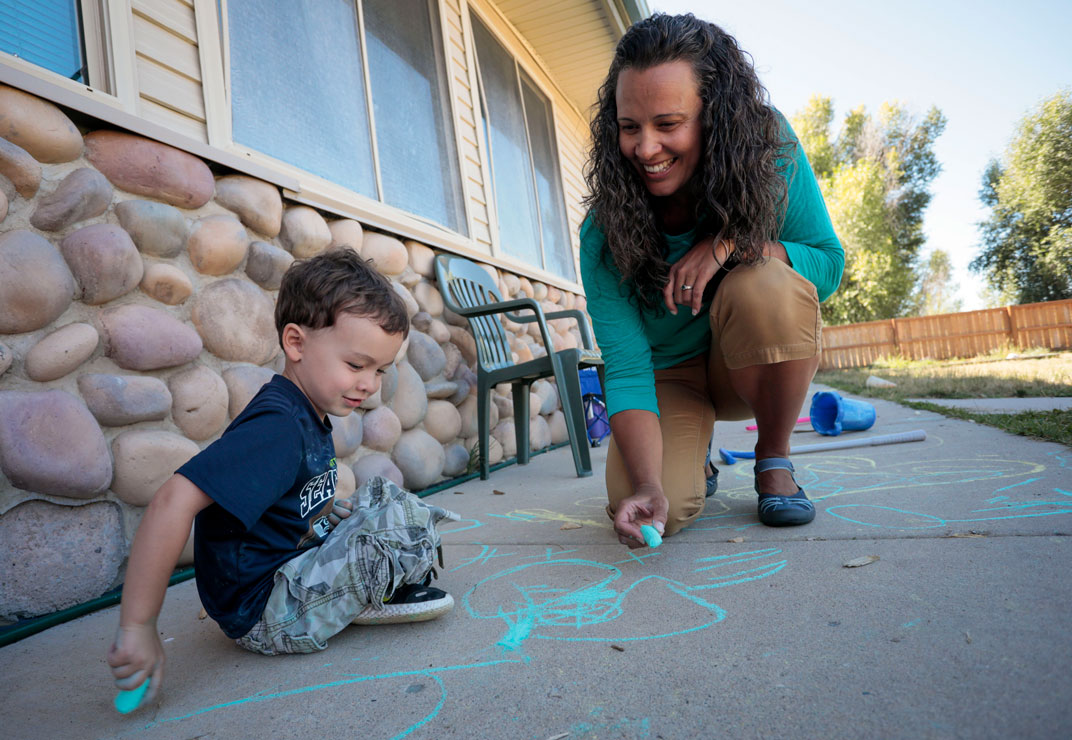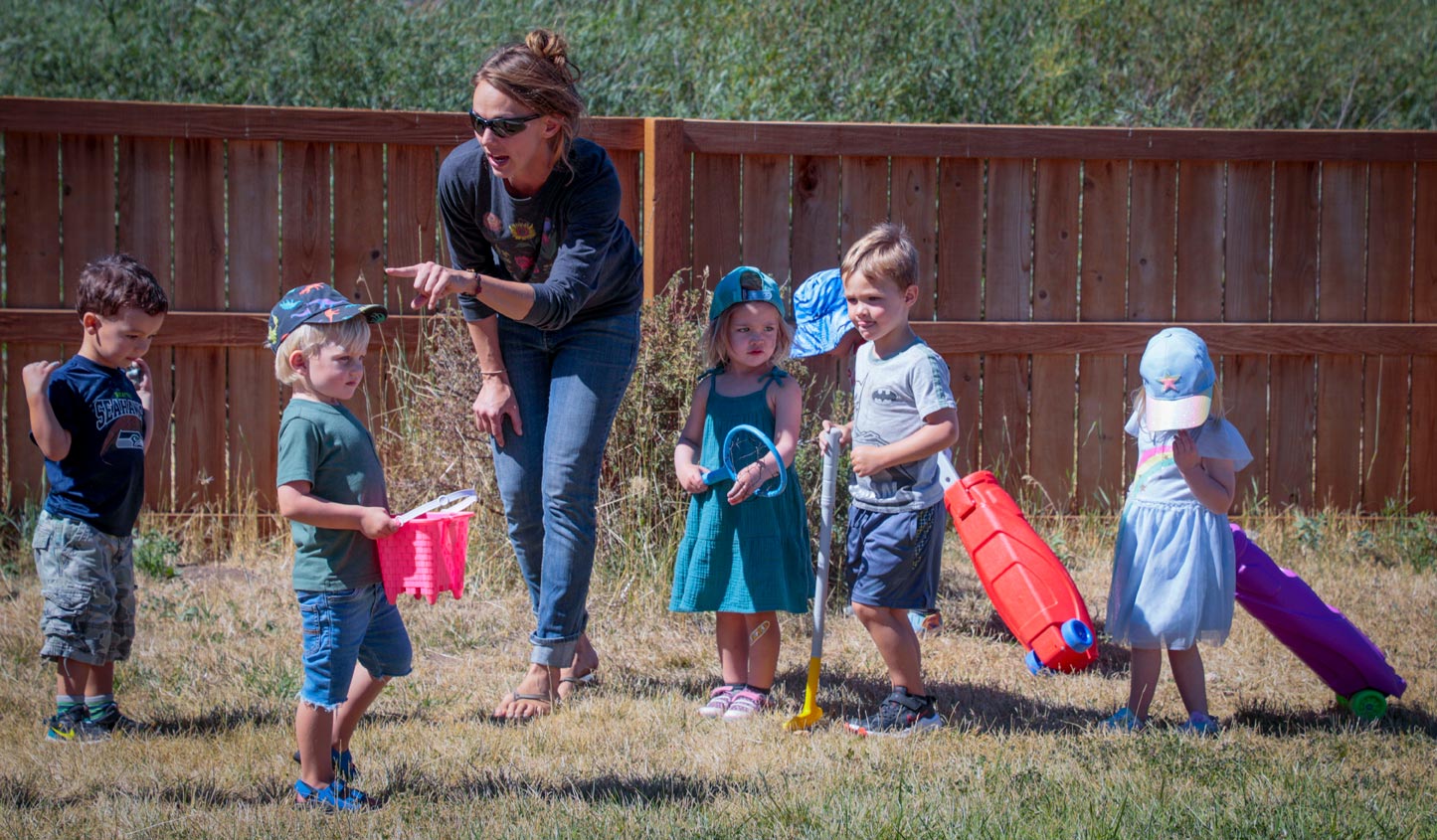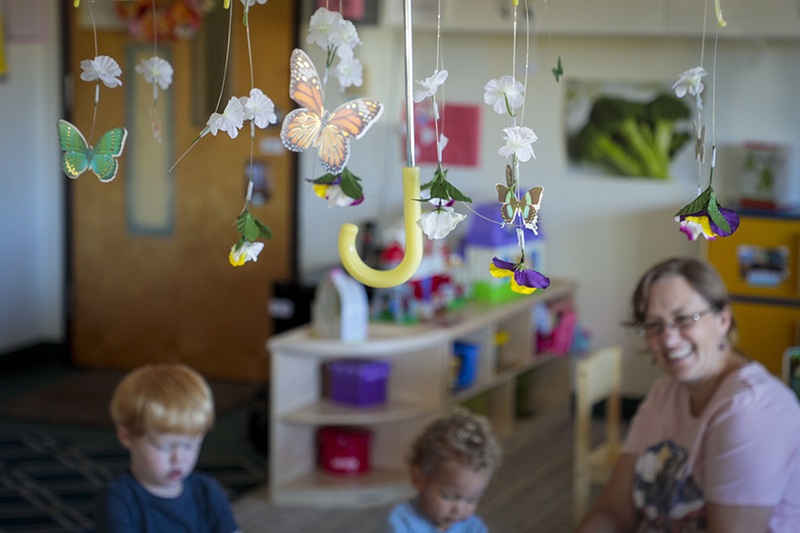
Jaiya Jermulowske plays with her son Kayson at Heritage Park Preschool in Steamboat Springs, Colo. on Aug. 17. Jermulowske works part-time at the preschool that her son attends. Photos by Joe Mahoney / Special to The Colorado Trust
Jaiya Jermulowske plays with her son Kayson at Heritage Park Preschool in Steamboat Springs, Colo. on Aug. 17. Jermulowske works part-time at the preschool that her son attends. Photos by Joe Mahoney / Special to The Colorado Trust
Timing was everything for Jaiya Jermulowske and her husband, Kory. They knew they couldn’t afford to have two kids in day care at the same time, so the couple—who live about 35 minutes south of Steamboat Springs—planned their second pregnancy around child care.
When her son, Kayson, was born, Jermulowske left her full-time job at a local nonprofit to mind him and run a babysitting business that had previously been her side hustle. When he turned two, she was ready to enroll him at the preschool next door to where her daughter, Ayla, attended. It was critical to Jermulowske that both of her children were at the same location, so they had matching drop-off and pick-up times.
Registration for the school year opened at 7 a.m. on a Tuesday. Jermulowske slept at a friend’s house in town to be closer to the preschool, woke up at 5 a.m., and was the first car in line at 5:30 a.m.
He got in.
***
Erica Lindberg lives outside of Black Hawk, along the Peak to Peak Scenic Byway. There’s only one day care in the nearby area, and its infant room is currently closed because there aren’t enough staff. Her son, Bjørn, is six months old. He’s her first child, and she wasn’t aware that she needed to start looking for child care options while she was still pregnant. At least, that’s what she was told when she began calling day care facilities in Boulder when he was three months old. Waitlists, she discovered, cost $50 to $150 to join.
Lindberg and her husband were able to find an option for child care two days a week, but it was ultimately too far from their home to make sense with their full-time work schedules. So, she’s turned to a neighbor, who will care for Bjørn and her own two children when Lindberg returns to work in September.
***
One month into her first pregnancy, Talita Garcia put her name on the waitlist of all the child care centers within a 30-minute drive of her home in Carbondale. Her son was almost six months old when she was finally offered a spot—which was then delayed due to lack of staff. She managed to finagle a temporary, two-month placement before Baby G (his mom asked that we not use his full name) finally started at the child care center five days a week.
The venue isn’t Garcia’s first choice, but at her preferred option, her now 17-month-old son is still number 81 on the waitlist. That child care center currently has waitlists for all of its age groups, ranging from 141 people on its infant list to 132 for one of its two preschool-age offerings—adding up to close to 600 families total (although some of those could have found alternate care in the meantime). Yet only 30 to 40 new families are enrolled each year across all age groups.
“I don’t feel I have any other options,” Garcia said.
***
These stories are not unusual in Colorado. Or exceptional.
“Every woman that I know everywhere is struggling with finding child care,” said Kelley Manley, a freelance journalist who lives in Denver with her husband and two daughters (three and five years old).
Colorado, like much of the country, is facing a child care crisis.
Though licensed child care facilities are more prevalent in urban areas, child care supply is scarce across the majority of the state, according to the Center for American Progress (CAP). And it’s sorely needed: 70% of families with children age six or younger in Colorado have both parents in the workforce.
Prior to the COVID-19 pandemic, CAP found that half of the country lived in neighborhoods that qualified as child care deserts (which CAP defined as “places where there are three or more children for each licensed child care slot”). In general, the nonpartisan policy institute’s pre-pandemic analysis of 19 states and the District of Columbia found that there’s “enough licensed child care to serve just 23% of infants and toddlers.”
Colorado fares even worse: It has enough licensed child care providers to cover less than 19% of those children. More than half of the state’s population lives in a child care desert—an unfortunate reality that’s even more common among Black, Hispanic/Latino, rural and/or low-income families.
The COVID-19 pandemic has worsened an already overburdened and under-resourced system. “This has been a problem for decades and decades,” said Diane Girouard, state policy analyst for Child Care Aware of America (CCAoA), a national organization that advocates for improved child care access and policies. “The pandemic has just made it so much more difficult.”
Lindberg, the mom and marketing professional based outside of Black Hawk, expects her six-month-old will finally be accepted into their local facility when he’s between 18 and 24 months old. After spending three months looking for a nanny, she settled on paying their neighbor $18 per hour to watch Bjørn for 30 hours per week.
“It’s a big deal. I had a meltdown not that long ago over this,” she said.
Summit County, which includes the mountain-resort bedroom communities of Dillon, Frisco and Silverthorne, currently has a licensed child care waitlist with 600 names on it.
“What we hear from families, if they’re families of infants and toddlers, is they get on the list and just never get a spot because there just aren’t spots available,” said Lucinda Burns, executive director of Early Childhood Options, a resource and referral agency for families and professionals based in Dillon.
In Steamboat Springs, near where Jermulowske lives, the town had 60 licensed spots for children under two, pre-pandemic. “That’s 60 spots for 440 children” who could need care, says Melinda Maas, executive director of Heritage Park Preschool, the same school Jermulowske parked in front of at 5:30 a.m. to register her son.
Heritage Park can currently enroll 40 children between one and five years old. Maas is in the process of converting a classroom to serve children younger than three and hopes that’ll open up five to 10 more spots for kids.

Ann Yager leads a group of three-year-olds looking for grasshoppers at Heritage Park Preschool in Steamboat Springs.
Maas says she receives multiple requests each week from parents seeking child care. “Anytime they call and I have to turn them away, I feel so bad because I know there are not really many options out there for them,” she said.
Last year, Maas had a family show up at 8 p.m. the night before registration opened to nab a spot for their kid. She had to put them on the waitlist. The classroom for their kid’s age group was already full.
***
Like many other industries, child care has a staffing problem. The sector as a whole lost more than 10% of its workforce during the first 18 months of the pandemic, or nearly 127,000 workers nationwide, a much higher turnover than previously seen.
“Child care is still very much in crisis across the country,” Girouard said. “Child care programs remain short-staffed, and providers are burned out.”
On average, early childhood educators are paid less than $12 per hour, per CAP. (The livable wage for one adult with no children in Denver County is now more than $20 per hour.) Workers are primarily female and, more specifically, women of color.
Between December 2019 and March 2021, almost 9,000 child care centers in 37 states closed their doors (a 9% loss in programs). At the same time, nearly 7,000 licensed family child care programs, or home-based care offerings, shuttered in 36 states (a 10% loss), according to a recent report from CCAoA.
Parents and employers are feeling the crunch. Maas was forced to close a classroom for six months last year after losing two teachers—one to retirement, another for family reasons. Ten families were stuck without child care until new spots became available. She’s currently hiring for two other positions.
“Every center in Steamboat is hiring for multiple positions. If they could hire, then they would be able to take in more kids,” she said. Steamboat Ski Resort is planning to open a child care facility, primarily for its employees, by the end of the year. The county is also considering launching a preschool or infant center, she said.
That’s good news, but she’s not sure how they’re going to staff them when the current venues can’t retain enough qualified teachers. The cost of living in resort communities like Steamboat is another factor making it harder to recruit and retain staff, even if a child care center were able to offer above-average wages.
“If we had more funding and could pay our teachers more, then maybe more people would be interested in getting into this field and interested in staying and feel valued, and feel the hard work they put in every day is worth it,” Maas said. “They’d be able to afford to live here.”
Lack of child care is a community problem, not just for families with young children. Struggles with child care access and affordability cost the country an estimated $57 billion annually due to lost earnings, productivity and revenue.
An inability to find consistent, quality, affordable care also pushes women—who continue to bear the burden of child care responsibilities—out of the workforce. A Colorado fact sheet from the White House notes that the Centennial State has a 21% gap in workforce participation between mothers and fathers. (CAP data also shows that the labor force participation rate for moms of young children is 3% lower in child care deserts than non-child care deserts.) It also impacts productivity and opportunities for advancement as parents are forced to stay home when their child care falls through or a classroom is closed because of, say, a COVID exposure.
Kids also bear their own burdens by missing out on the long-term social, emotional, health and academic benefits that come with day care or preschool. High-quality early childhood education has been shown to increase school readiness and, later, high school graduation rates.
“All these kids, their first five years are the most important years, and if we’re not valuing that and not making sure they have that quality education during those important years—then what is that going to do to our future?” Maas asked.
***
Access to child care is one hurdle. The next one families must overcome is affordability.
CCAoA calculates that child care in the United States runs, on average, around $10,000 per child annually; in Colorado, it ranges between $9,528 and $15,881.
To be considered affordable, the federal government recommends that child care comprise 7% or less of a family’s household income. Yet nationally, families are spending an average of 13% of their income on child care. Data released by the Bell Policy Center earlier this year shows that Colorado families are spending even more—16% to 27%. Quality center-based infant care, the report notes, costs “44% more annually than a year of public college tuition.”
These numbers are only becoming more burdensome. KDVR reported in February that the price of child care shot up 41% during the pandemic. In the West, child care is the second-largest household expense after housing, per CCAoA.
Carbondale’s Garcia, who works remotely as a recruiter, spends $1,300 per month on her son’s day care. “I get paid twice a month. One paycheck is basically going to pay for his day care,” said the 33-year-old, who is also a stepmom to a seven-year-old daughter. “It’s super stressful because we don’t have any money left at the end of the month after paying for the mortgage, groceries, health insurance.”
She and her husband have no family nearby they can call for help, and they don’t qualify for tuition assistance. “It’s basically like we have to arrange ourselves around the child care,” she explained. “When [Baby G] is sick, we don’t have an option; I have to take time off work, even unpaid time off. That obviously affects our finances.”
She continued: “I don’t feel like I want to have more children if I have to go through this again. Before, I used to think I’d like to have two.”
In Summit County, Burns said the most expensive infant and toddler programs run $2,000 per month. Steamboat’s Heritage Park charges $78 per day for toddlers and $73 per day for preschoolers; that’s around $1,500 per month for care five days a week. Executive director Maas said 30% to 40% of their families are receiving some form of tuition assistance.
“One month of child care is basically a second mortgage,” Steamboat-area mom Jermulowske said. “My kids are 3.5 years apart and we were conscious with that. We could not afford to live here and have two children in day care.”
The federal government provided some assistance with the passage of the American Rescue Plan Act in March 2021, which pushed more than $40 billion into early childhood care and education—the largest single investment in the sector. President Biden’s proposed Build Back Better Act would have invested an additional $400 billion, but the child tax credit and child care subsidies have been cut from the most recent iteration of the bill.
In lieu of that sustainable federal funding source, CCAoA’s Girouard said states have stepped up to fill in some of the critical gaps. In 2019, the Colorado State Legislature made full-day kindergarten free. And, in April, Gov. Jared Polis signed a bill that provides all four-year-olds with 10 hours a week of free preschool. The state also operates a program that provides financial assistance to families in poverty or experiencing homelessness.
While she applauds state-level efforts, Girouard said “significant, sustained funding” is still needed “to prevent the collapse of our child care system.”
And, of course, being able to pay for child care only becomes an issue if you are able to actually secure child care first.
***
Parents have long lived by the adage “it takes a village”—turning to family and friends to help out in a pinch. Nowadays, though, they’re not looking for that extra hand so they can indulge in a two-hour date night. Informal family, friend and neighbor care is a critical piece of the care puzzle that many parents are forced to string together.
A few years ago, Manley, the Denver journalist, said she was able to hire an experienced sitter for $20 per hour. Now, the bottom is $25 per hour. She recently spent six weeks trying to find a nanny before resorting to a mix of neighborhood high school and college kids who could babysit over the summer during the hours she was working (her husband travels regularly for work, so Manley is the primary caregiver).
“I worry about the toll this is going to take on women’s mental health because you can’t get away,” she said.
Going into the fall, she won’t have any help again. “I’m dreading it,” she said of the process to hire a new nanny. “It’s just super stressful, and super stressful to start and stop.”
Shuffling between child care facilities or from a day care to a neighbor’s house is becoming more commonplace. Not only does this add to parental stress, it can also negatively impact a child’s growth and development, Early Childhood Options’ Burns said.
“All the work we’ve put into it over the years,” she said, “and parents are still struggling to find child care.”
